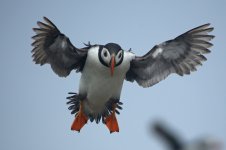Nutcracker
Stop Brexit!
Yeah, that would be a test alright!
What is it, are you willing to tell us at this stage? My (inexpert) guess is Chaffinch.
Reckons it's a brambling...
Yep, Brambling is correct! March this year, in Northumbs.
But I hope Pine Warbler wasn't its second choice??!




![Loxia_20090225_Linn_of_Dee_LH6D8670[1].jpg](/data/attachments/592/592533-9935069fabd8c6c57445e83dcb56807a.jpg)

